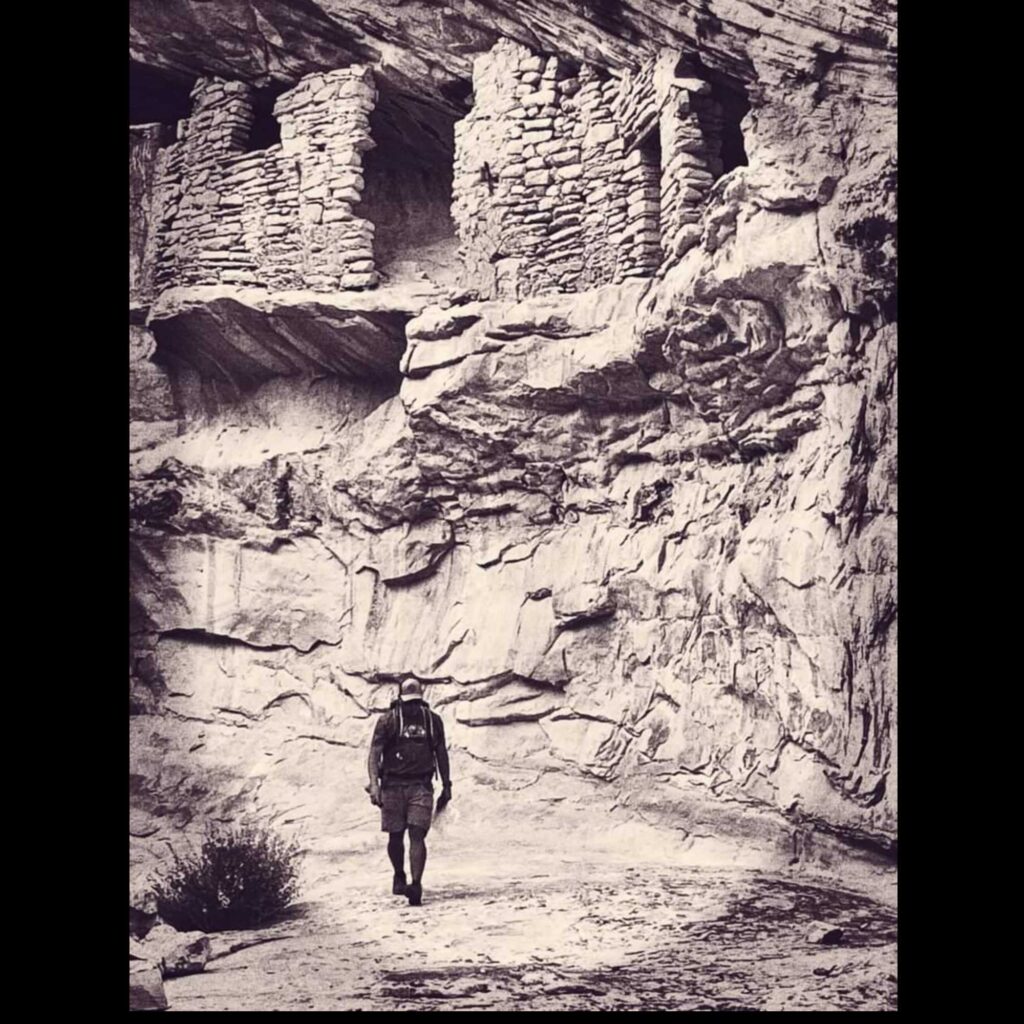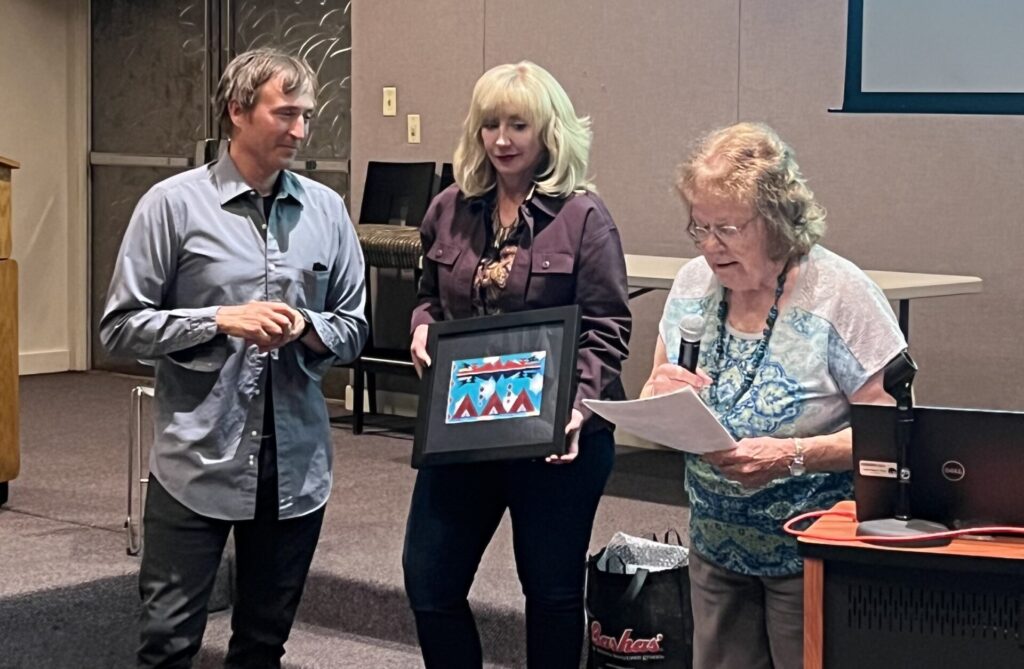Dear Friends, Weather permitting, I�m in Washington Crossing, Pennsylvania, as you open this note. Of course, you never know what you�ll encounter on cross-country flights this time of year. It�s time to visit my daughter, grandson (11), and granddaughter...
Dear Friends,
Weather permitting, I�m in Washington Crossing, Pennsylvania, as you open this note. Of course, you never know what you�ll encounter on cross-country flights this time of year.
It�s time to visit my daughter, grandson (11), and granddaughter (9). I�ll miss a few weeks of Tucson mornings watching the Black-throated Sparrows, White-crowned Sparrows, and a seemingly endless supply of Mourning Doves as they devour the seeds I spread over the ground in front of our house. (Our Cooper�s Hawk is quite appreciative of that �endless supply of Mourning Doves,� however. I hope it remembers this boon so I don�t have to don my hawk-protection helmet next nesting season!)
We�ll be taking a break until the new year. On January 3, 2024, you should see my penultimate note to accompany Preservation Archaeology Today. That means my ultimate note will arrive on January 10. This, and many other things that have come to structure my days and weeks, will soon change. I�m getting comfortable with that.
In preparation for my year-end family visit, I have given myself a valuable gift. I�ve deactivated my Twitter account. After 30 days of non-use it will be deleted. I never used it much, but I�m most happy to be ex-Twitter.
Be well, Friends, and talk to you soon,

Retiring President & CEO, Archaeology Southwest
P.S. from Kate: No, I am NOT READY. Also, I suspect Bill would�ve given up on That Social Media Site a lot earlier but for a really great animal-friends account I also followed. Please be sure to take note of Jeff Reid�s notice below that he is collecting clothing and household items to be delivered to Cibecue. Blessed Solstice and Holiday wishes to you all!�
NM Extends Moratorium on Leasing of State Land in Greater Chaco
New Mexico�s public lands commissioner, Stephanie Garcia Richard, announced a 20-year extension of the state�s ban on new oil, gas, and mineral leasing around the Greater Chaco region. The extension continues decades of tribal efforts, along with efforts from elected officials, that sought to ensure the protection of 72,776 acres of state land that has cultural significance to the New Mexico Pueblos and area Tribes. � �The Greater Chaco landscape is one of the most special places in the world, and it would be foolish not to do everything in our power to protect it,� said Commissioner Garcia Richard in a press release. �This region is significant for our Indigenous communities and the cultural properties found in the area are irreplaceable. Action at both the federal and state level is necessary to ensure we are protecting these special resources.� Native News Online | Read more �
Read statements from several coalition partners detailing what this means for Greater Chaco via the National Parks Conservation Association� �
In Memoriam: Vincent�Randall
Vincent Edward Randall, 83, died around 6 p.m., Saturday, Dec. 16, according to his family. The Yavapai-Apache Nation announced funeral services will take place Friday and Saturday, Dec. 22 and 23. Randall was an enrolled member of the Yavapai-Apache Nation, Dilzh�e Apache Culture Director for the Yavapai-Apache Nation and served on Yavapai-Apache Nation Tribal Council as both a council member and as tribal chairman over numerous terms starting in 1962. He also served on the boards of the National Association for the Education of Young Children, the Association of American Indian Affairs, the Inter-Tribal Council of Arizona and the Working Group of Allied Apaches for the Native American Graves Protection and Repatriation Act. Christopher Fox Graham for Sedona Red Rock News | Read more �
We encourage you to watch the videos of Mr. Randall sharing his knowledge and perspectives that are included in the tribute.
Profile of Ute Mountain Ute Tribal Park
Rickey Hayes is a Ute Mountain Ute tribal member and the head interpretive guide at Ute Mountain Ute Tribal Park near Towaoc, Colorado. The tribal park is almost double the size of nearby Mesa Verde National Park, and includes dozens of archaeological sites, well-preserved cliff dwellings, pottery sherds and art on canyon walls. The park is a tribal enterprise encompassing the entirety of Mesa Verde�s backcountry and requires visitors to travel with a Ute Mountain Ute guide. In late September, KSJD attended a tour group led by Hayes, and recorded this audio postcard. Chris Clements for KSJD | Read more or listen now �
Audio: The Hopi Mesas
The Hopi Mesas are the final destination of a series of epic migrations that Hopi ancestors endured across the southwest and beyond. Drawn to this location by divine prophecy and life-sustaining water, the ancestral clans gathered, establishing their villages at the edge of the sheer cliffs. For over a thousand years, Hopi people have lived upon the mesas, in one of the longest, continuously inhabited settlements in the southwest. It�s known in Hopi tradition as Tuuwanaasavi, the Center of the Universe. Lyle Balenquah for KNAU Earth Notes | Listen now �
A GIS Librarian on Archiving Lipe and Matson�s Maps
In 1972, two archaeologists began a project on Cedar Mesa in southeastern Utah. The project combined their interests in settlement patterns and statistical applications to archaeology based on probabilistic sampling theory. Little could the two archaeologists know that the project would lead to a 50-year collaboration that resulted in numerous significant contributions to the field of southwestern archaeology, or that Cedar Mesa itself would become involved in a contemporary fight for Indigenous control of ancestral lands as part of Bears Ears National Monument. � Together, the two men assembled a wealth of data from Cedar Mesa over four decades that detailed the development of a cultural landscape from a natural landscape. The approach of considering the landscape as the unit for analysis was rare in archaeology at the time. Joshua Conver in the Moscow-Pullman Daily News | Read more �
Podcast: On American Indians, Anthropology, and Tribal Relations
In this episode, host Jessica Yaquinto welcomes Dr. Richard Meyers (Oglala Lakota), Tribal Relations Specialist at the Black Hills National Forest and the former Director of Graduate Studies and Associate Professor at Oglala Lakota College. Richie joined as part of the panel on Episode 73: Exploring the Ethics in Experimental Archaeology, and we knew we needed to have him back to do a one on one episode. We talk about various aspects of identity, as well as the challenges and benefits of working in a variety of types of positions across the field of Anthropology, academia, and federal service. Richie also talks about his current work as a Tribal Relations Specialist and provides important advice for anyone wanting to go into Tribal Relations specifically, but really any form of Anthropology more generally. Heritage Voices | Listen now �
Interview with Community Archaeologist Alexandra Jones
Alexandra Jones has unearthed a trove of accolades, from working as the chair of President Joe Biden�s Cultural Property Advisory Committee to serving as the president of the Society of Black Archaeologists. The founder of Jones Archaeology Consulting, the only archaeology firm run and operated by an African American woman in the United States, and the nonprofit group Archaeology in the Community didn�t actually grow up dreaming of becoming a real-life Indiana Jones. She was first introduced to the world of archaeology while attending Howard University, where she earned bachelor�s degrees in anthropology and history. � Today, she helps communities solve real-world problems with her Archaeology in the Community program. Jones recently spoke with Shondaland about why representation in archaeology is important, what misconceptions there are about the field, and where she sees it going in the future. Tykesha Burton for Shondaland | Read more �
Help the Cibecue Project
The Cibecue Apache provided valuable support during the thirty years of the Grasshopper Field School. Having been severely impacted by the viral pandemic, they now would benefit from donations of items normally given to Goodwill, especially clothing and small household items. To make a donation, contact me at [email protected]. Thank you, J. Jefferson Reid, Distinguished Professor Emeritus, University of Arizona.
Funding Opportunities: Archaeological Research and Travel
Research grants are awarded up to $1,400. These grants are open to students including the AAHS Board student representative, non-professionals, and professionals. Travel grants are awarded up to $700. These grants are available to students including the AAHS Board student representative, non-professionals, and professionals to help cover the costs of travel to professional conferences and workshops. AAHS accepts proposals for Research and Travel Grants annually between January 1 and February 15. Arizona Archaeological and Historical Society | Learn more �
Video Series: Living Languages (O�odham and Piipaash)
All living languages evolve over time. One way they evolve is with the development of new words. There was once a time when the O�odham and Piipaash languages did not have words for items such as horse, cow, car, money, etc. These words previously didn�t exist in our languages because these items hadn�t yet been introduced to us or had not yet been invented. As our ancestors experienced new things, they created new words so they could talk about them. We must continue to do the same if we want our languages to survive and thrive in the future. This video series will explain some of the processes our ancestors used to update their vocabularies. We continue to use the same processes today to create new words. Salt River Cultural Resources Department | Watch now �
Video: More than Subsistence
On Tuesday, December 5, 2023, Ashleigh Thompson (Archaeology Southwest) presented �More than Subsistence: How Anishinaabe Traditional Foodways Nourish Culture, Kinship, and Community Wellbeing� at The Loft Cinema and on Zoom. Her talk discussed how, across Indigenous country, Native people are revitalizing their traditional foods. Ashleigh explores the importance of traditional foods to her community�the Red Lake Ojibwe�and learns why these traditions are significant to culture, kinship, and community wellbeing. Archaeology Caf� (Archaeology Southwest) | Watch now �
Video: Circling the Presidio: A Tucsonense Food Map
Melani �Mele� Martinez honored the 15th edition of the My Arizona Lecture with a beautiful trip into the history of Tucson�s food scene. A native Tucsonense, her family has lived in the Sonoran Desert for at least nine generations, moving across borders and between rancho and pueblo spaces to create a tiny food store in the Presidio�El Rapido. Though the store closed its doors more than 20 years ago, it provides a mental map and a flavor memory that still reverberates in our city. Southwest Center, University of Arizona | Watch now �
For other new videos, be sure to check our Video Channel Roundup below.
Podcast: Changing the Narrative in Science & Conservation
Science and conservation in the United States is made up of primarily white scientists and Western ways of thinking. This is something that Sergio Avila saw clearly when he first came to the US from Mexico to study mountain lions and jaguars along the border. Here, we speak with Sergio about his experiences in conservation and the need to incorporate diverse ways of thinking into science that includes, respects, and learns from Indigenous communities and people of color. Sergio challenges conservationists to expand their role models away from authors like Ed Abbey and John Muir and look towards the written, spoken, and on the ground knowledge that is held within Indigenous communities and within communities of color. Science Moab | Listen now �
REMINDER: Jan. 9 In-Person (Tucson AZ) and Online Event: Indigenous Agriculture: Planting for Survival
With Michael Kotutwa Johnson. Join us in person or on Zoom for �.� Johnson will cover the importance of culture and belief systems that are integrated into Indigenous agriculture systems. He will also reference the importance of place-based knowledge or the relationships that exist to make Indigenous agriculture systems so resilient. Archaeology Caf� (Archaeology Southwest) | Learn more and register (free) �
Jan. 13 Online Event: Rediscovering the Fremont through Data-Driven Examination of Rock Imagery
With Elizabeth Hora. Over 1,000 years ago the Fremont lived in the Uinta Basin where they farmed, foraged, made villages, and�central to this talk�created some of the most incredible and intriguing rock imagery the world has ever seen. The rock imagery centers on depictions of human forms with gorgeous jewelry, intricate clothing and body paint, and holding implements of war and agricultural prosperity. Could these clues help us understand Fremont society? American Rock Art Research Association (ARARA) | Learn more and register (free) �
Jan. 27 In-Person Tour (Marana AZ): Archaeological Sites of the Marana Hohokam Platform Mound Community
With Paul and Suzanne Fish. 8:30 a.m. to noon. Our visit will include the Marana Platform Mound site (which was surrounded by 40+ residential compounds), a sampling of Hohokam agricultural field locations including specialized ones for agave cultivation, and a secondary compound center on the Tortolita Mountains bajada. The Marana Mound site is one of the very few Hohokam Early Classic period (1150-1300 CE) villages that has wholly escaped the destruction resulting from modern agriculture and urbanization and where adobe-wall remnants can be clearly identified on the surface. We also will visit the location where a segment of the nearly seven-mile-long Marana Mound site canal was identified from surface and excavated remains before that area was included in a modern housing development. These site visits will provide a basis for understanding the social and economic processes during the Early Classic period, when processes of Hohokam centralization and population aggregation greatly accelerated. Tour is limited to 20 people including guides. Reservations and donation prepayment ($35/$28) required by 5:00 p.m., Monday, January 22. Old Pueblo Archaeology Center | Email OPAC to learn more �
Video Channel Roundup
Find out which webinars and videos you missed and get caught up at the YouTube channels of our Partners and Friends. (And please do let us know if your channel isn�t in this list but should be!)
Amerind Foundation
Archaeology Southwest
Arizona Archaeological and Historical Society
Arizona State Museum
Aztlander
Bears Ears Partnership
Cotsen Institute of Archaeology at UCLA
Crow Canyon Archaeological Center
Grand Canyon Trust
Grand Staircase Escalante Partners
Mesa Prieta Petroglyphs Project
Mission Garden (Friends of Tucson�s Birthplace)
Museum of Indian Arts and Cultures
Museum of Northern Arizona
Old Pueblo Archaeology Center
San Diego Archaeological Center
School for Advanced Research
Southwest Seminars
The Archaeological Conservancy
Verde Valley Archaeology Center
Remember to send us notice of upcoming webinars and Zoom lectures, tours and workshops, and anything else you�d like to share with the Friends. Thanks!
The post NM Extends Moratorium on Leasing of State Land in Greater Chaco appeared first on Archaeology Southwest.









